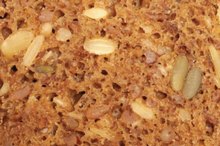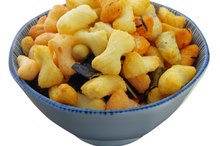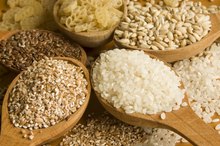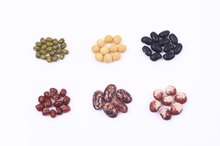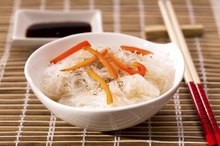Brown Rice and Blood Sugar
Your blood sugar is the amount of glucose circulating within your bloodstream. Glucose enters your blood when you eat foods rich in carbohydrates, which are broken down into glucose. Most healthy bodies are able to keep blood glucose levels within normal limits, but patients suffering from diabetes may develop abnormal glucose levels. By controlling your diet and eating healthy foods, such as brown rice, you can reduce your chances of developing diabetes or prevent blood sugar abnormalities if you already have diabetes.
Brown Rice
Brown rice and other complex carbohydrates, such as millet, steel-cut oats and legumes, take longer to digest. A longer digestion time prolongs your sense of fullness and helps keep your blood sugar levels within normal ranges. However, simple carbohydrates, including white rice, soda, candy and white flour, are digested faster and tend to increase blood sugar levels quickly. Furthermore, refined or processed carbohydrates, such as soda and white rice, contain few nutrients, which can decrease overall nutritional value.
- Brown rice and other complex carbohydrates, such as millet, steel-cut oats and legumes, take longer to digest.
- However, simple carbohydrates, including white rice, soda, candy and white flour, are digested faster and tend to increase blood sugar levels quickly.
Brown Rice and Glycemic Index
List of Slow-Release Carbohydrate Foods
Learn More
Glycemic index, or GI, measures the effect certain foods have on raising blood sugar. Food with a low GI do not cause a rapid rise in blood sugar levels and are generally better tolerated by diabetic patients. Brown rice has a relatively low GI of 55 and is, therefore, able to keep blood sugar levels more stable.
Less Sugar Release
All carbohydrates cause an influx of glucose into your body. Brown rice provides a much lower sugar release when compared with other forms of rice. In fact, brown rice released 23.7 percent less sugar when compared with milled rice, according to a 2006 article published in the “International Journal of Food Sciences and Nutrition." By releasing less sugar, brown rice helps prevent high blood sugar levels.
- All carbohydrates cause an influx of glucose into your body.
- By releasing less sugar, brown rice helps prevent high blood sugar levels.
Lower the Risk for Diabetes
The Carbohydrates in Glazed Doughnuts
Learn More
Diabetes mellitus is a disease characterized by chronically high sugar levels. Its causes range from insufficient levels of the hormone insulin to increased insulin resistance in cells. Substituting brown rice, or other whole grains, for simple carbohydrates, such as white rice, reduces your risk of developing diabetes, an article in the June 2010 issue of “Archives Internal Medicine” states. Eating brown rice instead of white rice or other refined carbohydrates reduces your risk of developing diabetes by 16 percent.
- Diabetes mellitus is a disease characterized by chronically high sugar levels.
- Eating brown rice instead of white rice or other refined carbohydrates reduces your risk of developing diabetes by 16 percent.
Related Articles
References
- HelpGuide.org: The Glycemic Index: Choosing Healthy Carbs
- Archives of Internal Medicine; "White Rice, Brown Rice, and Risk of Type 2 Diabetes in U.S. Men and Women"; Qi Sun, et al.; 2010
- International Journal of Food Sciences and Nutrition; Blood Glucose Lowering Effects of Brown Rice in Normal and Diabetic Subjects; L.N. Panlasigui; 2006
- HelpGuide.org: Diabetes Diet and Food Tips
- Labensky SR, Hause AM, Martel P. On Cooking: a Textbook of Culinary Fundamentals. Boston: Pearson; 2015.
- Rice, white, short-grain, enriched, cooked. FoodData Central. U.S. Department of Agriculture. Published April 1, 2019.
- Rice, brown, cooked. FoodData Central. U.S. Department of Agriculture. Published April 1, 2019.
- Roy P, Orikasa T, Okadome H, Nakamura N, Shiina T. Processing conditions, rice properties, health and environment. Int J Environ Res Public Health. 2011;8(6):1957-76. doi:10.3390/ijerph8061957
- Fung KY, Cosgrove L, Lockett T, Head R, Topping DL. A review of the potential mechanisms for the lowering of colorectal oncogenesis by butyrate. Br J Nutr. 2012;108(5):820-31. doi:10.1017/s0007114512001948
- Harris KA, Kris-Etherton PM. Effects of whole grains on coronary heart disease risk. Curr Atheroscler Rep. 2010;12(6):368-76. doi:10.1007/s11883-010-0136-1
- Cermak NM, van Loon LJ. The use of carbohydrates during exercise as an ergogenic aid. Sports Med. 2013;43(11):1139-55. doi:10.1007/s40279-013-0079-0
- Jeon YH, Oh SJ, Yang HJ, Lee SY, Pyun BY. Identification of major rice allergen and their clinical significance in children. Korean J Pediatr. 2011;54(10):414-21. doi:10.3345/kjp.2011.54.10.414
- Nowak-Węgrzyn A, Chehade M, Groetch ME, et al. International consensus guidelines for the diagnosis and management of food protein-induced enterocolitis syndrome: Executive summary-Workgroup Report of the Adverse Reactions to Foods Committee, American Academy of Allergy, Asthma & Immunology. J Allergy Clin Immunol. 2017;139(4):1111-1126.e4. doi:10.1016/j.jaci.2016.12.966
- Qian Y, Chen C, Zhang Q, Li Y, Chen Z, Li M. Concentrations of cadmium, lead, mercury and arsenic in Chinese market milled rice and associated population health risk. Food Control. 2010;21(12):1757-1763. doi:10.1016/j.foodcont.2010.08.005
- Havenaar R. Intestinal health functions of colonic microbial metabolites: a review. Benef Microbes. 2011;2(2):103-14. doi:10.3920/bm2011.0003
- Labensky SR, Hause AM, Martel P. On Cooking: a Textbook of Culinary Fundamentals. Boston: Pearson; 2015.
Writer Bio
Joseph Pritchard graduated from Our Lady of Fatima Medical School with a medical degree. He has spent almost a decade studying humanity. Dr. Pritchard writes as a San Francisco biology expert for a prominent website and thoroughly enjoys sharing the knowledge he has accumulated.
